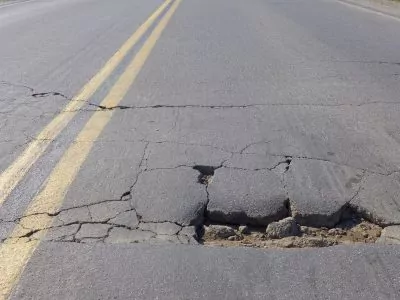Suing a governmental entity or agency in a personal injury case is generally allowed under the law. Governmental entities hold themselves immune from liability, with some exceptions.
Sometimes such lawsuits are allowed in case of negligent road repair or maintenance, for example, that resulted in a car accident with personal injury and/or property damage.

And if you were injured or have significant property damage on government property, it may well pay to look into filing a claim. It costs nothing to notify the government with a formal claim, as is required before a lawsuit can go forward.
Federal, state and local governments protect themselves against lawsuits with lots of governmental immunities, but exceptions can be made. Some governments allow some legal actions even though they are protected from liability under immunity laws. The immunity accorded to state governments or the U.S. federal government is called “sovereign immunity.” The immunity accorded to municipalities or counties is called “governmental immunity.”
If the negligence in the repair or maintenance of a road was egregious or gross, in other words very negligent, an exception can be made. And the government in question can allow a person injured in an accident on a public road to bring a lawsuit.
Despite immunity, government agencies allow exceptions so people who are injured can recoup their medical bills, lost wages and be compensated for pain and suffering and loss of consortium with a spouse.
Sometimes municipalities or states will allow such lawsuits only if they have the type of insurance that covers damages so taxpayers won’t have to foot the bill. Rather, the government agency’s insurance company will pay.
Strict time limits for bringing a lawsuit
The state of California’s website California Courts: The Judicial Branch of California explains when people can bring lawsuits against the state under the state of limitations:
When you sue a government agency, you first have to file a special claim (called an ‘administrative claim’) with the government office or agency before you file in court. You have to use the government’s form to file the claim.
- For personal injury or personal property damage, you must file your administrative claim within 6 months of the date of the injury. (There are a few exceptions. Review California Government Code section 905 and section 911.2 or talk to a lawyer.)
- For breach of contract and real property damage cases: You must file your administrative claim within 1 year of the date the contract was broken or the real property damage occurred.
After you file your claim, the government has 45 days to respond. If the government agency denies your claim during the 45 days, you have 6 months to file a lawsuit in court from date the denial was mailed or personally delivered to you. If you do not get a rejection letter, you have 2 years to file from the day the incident occurred. But do not count on having 2 years to file your claim.

The statute of limitations for government claims can be complicated to figure out. Talk to a lawyer if you have any doubts about how much time you have. Click for help finding a lawyer. Your court’s self-help resources may also be able to help you find out more about the statute of limitations in your case. Click to find help from your court.
The key is to hire a good lawyer so he can file a notice to bring a lawsuit within the short time frame allowed under state law: six months in case of personal injury, wrongful death or damage to personal property.
Exceptions to the rule
There are some exceptions to the rules against suing governments, among them:
- You can sue if a government employee acts negligently, for example an accident with injuries caused by a speeding or intoxicated city worker or bus driver.
- You can sue if public property is in bad repair or has not been maintained properly. For example, you could sue if a road washes out, there are no warning signs or lights and you crash and get injured. Or you can sue if you are walking and get injured because a sidewalk is in bad repair.
- You can also sue a school district for negligent employee behavior that results in injury to your school-age child or another employee of the district.
Even so, the government may still not be liable and may be immune to any claims against it. This is true often when it concerns failure to supervise activities on government property. Also, the government may be immune if did not become aware of a maintenance problem or damage to a roadway in time to correct it, for example.
The best course of action with any personal injury is to consult a lawyer. Attorneys know how to bring lawsuits private persons or public employees, companies, government agencies or other types of organizations. It can be a lot more difficult to bring a claim against a government, but an experienced, skilled attorney knows exactly how to proceed.
Who is responsible?
Before bringing a lawsuit, it’s important to determine who was responsible for the bad road conditions. Potholes, missing guard rails, erosion and even bad road design can cause accidents. It is a complicated matter deciding who may and may not be sued.
Cities, counties and states maintain public roadways. Sometimes they maintain them as a joint venture. A city might be the one that does the de-icing and plowing of snow; while the state might be the one responsible for paving the roadway and filling pot holes.
A good attorney figures out which agency should be held to account with a lawsuit in court, and further if they can be sued at all.
What do you have to prove to win a lawsuit?
If you are injured because of road conditions, you will have to prove that it was the road condition that caused your injuries, damage to your vehicle, or even the death of a close relative. Beyond that, you must prove that the agency or company you are suing was responsible for maintaining the road was negligent. It did not provide a safe road to drive on. Or, you would need to show that they did not give adequate warning of a potential hazard.

In addition, the person bringing the lawsuit, known as the plaintiff, has to show that the bad road condition caused the injury to him or his passengers or damage to the car. This can be difficult to prove, especially if you’re suing over damage to the car.
Sometimes, a pothole or debris in the roadway causes damage to a car that isn’t noticed right away. It can be difficult to go back over your route to show exactly what damaged your car.
If you don’t have a police report, photos, or witnesses to the accident, it will be your testimony alone in court. The government agency could argue that it was your bad driving that caused the damage to your vehicle. Or they could claim it was bad weather that caused the accident.
What to do in case of an accident
You must submit a written claim detailing your damages to any state, county or city that you sue before you file a lawsuit. This is different than if you were to bring an action against a private person, company or organization.
In your claim include:
- Your name and address.
- Give the mailing address where the government should send notice of the claim.
- A list of damages, including those mentioned above: medical expenses, loss of wages from work, etc. Do not go into a lot of detail with this. Describe your injuries in general terms, such as “neck and head injuries” or “leg injury.” Say you have lost income from work but don’t go into how much you earn or how much time you missed. Save that for later. Also, give a short description of damage to your vehicle or other property.
- A description of what happened during the accident, giving the place, the date and how you were hurt. This need not be a long description either. You will have time later to provide full details. Make a simple statement, for example, “On August 18, 2018, I was injured driving west on Green Street when a city public works truck ran into my vehicle from behind near the intersection with High Street.”
- Give the name of the government employee who caused the accident if you know it. If you don’t know, don’t worry about it. Just say you don’t know. You can still bring a claim if you don’t know the identity of the person who caused the accident.
- State how much compensation you expect to receive but state a higher amount than you anticipate your expenses to be. If you think your damages will amount to around $5,000, say you are seeking $25,000. This is legal. It is just an opening bid, and the number will likely change as you begin to negotiate.
You may file your claim with the governing board, such as a city council or county commission, or with the county or city clerk. If you have a claim against the state, file it with the California Department of General Services (DGS), Office of Risk Management. The agency may even have a claim form that you can fill out.
The Sacramento Public Law Library website warns (Saclaw.org PDF file here), “With very few exceptions, you cannot sue the government for money damages unless you have filed a written claim within the legally specified time period.”
Of course, it would be better if a good personal injury attorney did this paperwork and got the legal claim started. The attorneys and staff at Krasney Law have experience in bringing lawsuits against both governmental and private entities. We will do everything exactly according to law to enhance your chances of getting a settlement or winning a lawsuit.
After you file your claim
After you file your initial claim, wait for the government’s response or non-response. Saclaw.org states:
The agency has 45 days after receiving your claim to take action. The agency will typically conduct an investigation of your claim.

If their findings support your allegations, the agency will attempt to settle with you. If the agency rejects your claim, they will notify you in writing that you can pursue the matter in court. This written notification is often called your “right to sue letter.”
If the agency takes no action within 45 days, the claim is deemed denied and you may sue the agency in court. Under California Government Code 945.6, you must sue within 6 months from the date of the postmark or personal delivery of your right to sue letter. If the agency does not provide any written notice rejecting your claim, you have two years from the date of injury or damage.
Also, when you file a claim you may actually be helping other people by preventing future accidents. The Saclaw.org PDF states: “Filing a claim gives the agency the opportunity to settle the claim before a lawsuit is filed and to investigate the claim so that it can properly defend itself, or to correct the conditions or practices that led to the claim.”
If the governmental entity corrects the conditions or practices, then injury or property damage is less likely to happen to other people.
Krasney Law can represent you
If you need representation, you pay nothing for Krasney Law to assess your case and explain your options to you at your first meeting. Then Krasney Law collects no fees unless you receive a monetary settlement, or your case goes to trial and you win. The bottom line is, “No Recovery – No Fee”
Even if you don’t hire us to shepherd you through your entire case, at least consider hiring us to review your settlement documents with you. Sometimes you can realize a better settlement than the insurance company’s first offer. We posted a blog about how unscrupulous insurance adjusters can be.
If you were injured in an automobile or other type of accident that involved a government employee or happened on government roads or property, contact us today for a complimentary consultation.

